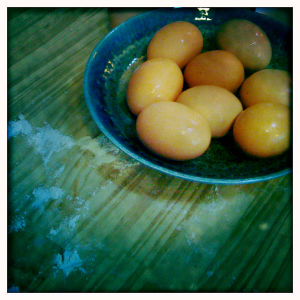Category 4
Category 3
Category 2
Category 1
We specialize in elevating content creators like you through bespoke social media strategies that not only capture attention, but also drive engagement.
Stride Social
Welcome to
Last night I made the most delicious quiche with asparagus and spinach. The meal was inspired by the free-range eggs I scored at last weekend’s farmer’s market. I have been shopping this farmer’s market for a year now and just discovered the eggs.
You have to know to ask for the eggs that are stacked in the back of a pick up truck. I asked the farmer, an older gentleman, if he has always offered eggs, “just for the last 20 years he answered.” “Are the chickens grass fed?” he set down a bunch of beets and carrots on the scale for another customer, “my chickens eat grass, bugs, and leftover veggies.”
The water footprint of a single egg is about 23 gallons of water. The color of water embedded in an egg, green (rain water) or blue (surface water), depends on how the chicken is raised. The two dozen eggs I took home with me were green water eggs. The chicken’s main source of food is the grass on the pasture grown on a diet of raindrops.
Free range hens scatter their manure around the farm. The chickens fertilize the soil, which in turn minizing or eliminate the need for synthetic fertilizers.
About 300 million egg laying chickens live in battery cages lined up and stacked in huge warehouses. These chickens produce huge amounts of manure. Some of this manure will find itself trucked and scattered onto farms. But often, piles of manure will runoff into local streams and rivers or seep into ground water supplies. Manure is rich with nitrogen which is necessary to sustain life. Too much nitrogen in rivers kills fish and destroys underwater ecosystems creating “dead zones.”
The USDA provides vague guidelines for free-range eggs. A free range egg only has to demonstrate “that the poultry has been allowed access to the outside.” It is easy to imagine how this definition can be stretched. When I pick up a carton of free-range eggs in the grocery store I think about the description of a poultry farm in the book Omnivore’s Dilemma. Michael Pollan writes how “access to the outside” was an open door leading to a small sod grass area. Even when he tried to coax the chickens outside they would not follow.
This is not to say that free-range eggs, defined as eggs from a chicken that live its life on a farm roaming the pasture, do not exist in a grocery store. I plan to call and visit these farms in the coming months. In the meantime, I will buy my eggs from the farmer who keeps the eggs in the back of his pickup truck.
Go out and find your own free range eggs from chickens who happily pluck the fresh grass and worms directly from the soil. Once your eggs celebrate with the following quiche. You will not be disappointed!
Green* eggs, Asparagus and Spinach Quiche
*Eggs produced from chickens raised on a diet of rain fed grass, rain fed insects and rain fed grains.
6-8 organic asparagus stalks
2 tablespoons dry farmed olive oil
4 organic eggs beaten
1 cup organic milk
1 tablespoon dry farmed flour
1/2 bunch of organic spinach
1 cup shredded cheese, use your favorite cheese or combination. I used Monterey Jack
1/2 teaspoon salt
Fresh cracked pepper to taste
1/2 teaspoon nutmeg
Garnish with shredded organic parmesan cheese
For the pie crust I suggest making your own. If you do purchase a pre-made crust, look for one with the least amount of ingredients. If many ingredients require a PHD in science to understand, not a good sign.
Preheat oven to 325 degrees.
Sauté the asparagus and spinach separately with one tablespoon of olive oil each. If you like garlic sauté with chopped garlic. Slice the asparagus stalk diagonally into about five pieces or smaller either before or after you sauté.
Whisk eggs in a medium size bowl. Add shredded cheese, flour, milk, salt, pepper, nutmeg, asparagus and spinach. Incorporate together and pour into the pastry shell.
Place in the center of a cookie sheet. Bake for 35-45 minutes. I check on the quiche in five minute intervals until done after the first 35 minutes.
Let the quiche set for 10 minutes before serving. Shred parmesan cheese on top and serve.
(Recipe inspired from GroupRecipes.com Artisan Asparagus Quiche Recipe)
Leave a Reply Cancel reply
Ready to take Action?

Thanks for enlightening me on water. I tried the quiche and it was fantastico.